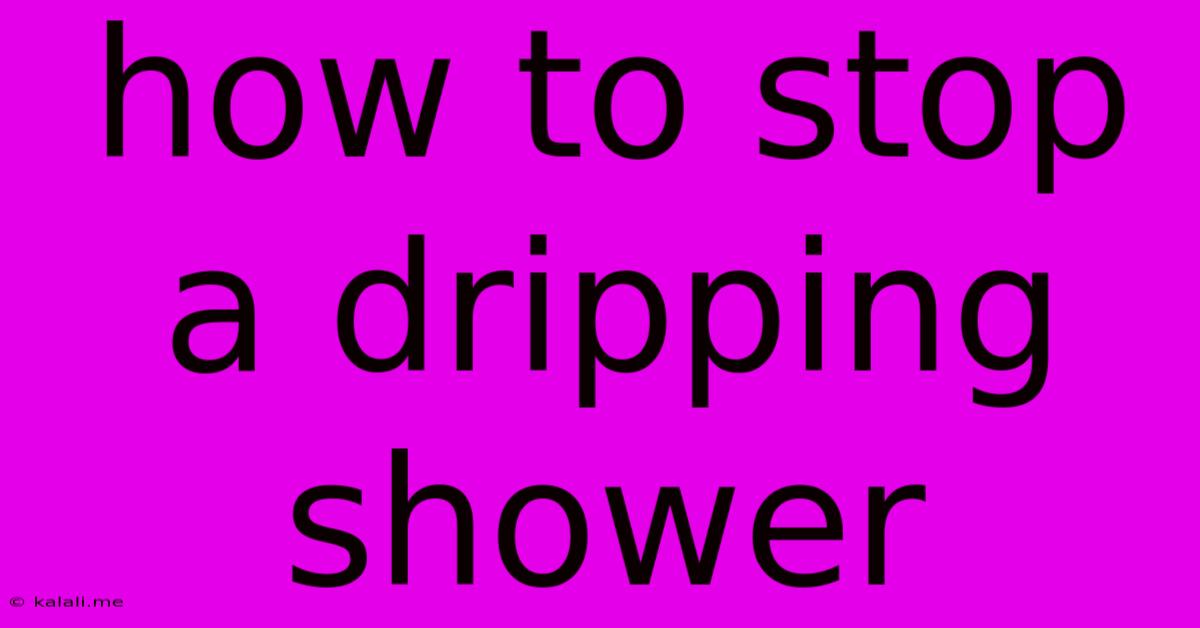How To Stop A Dripping Shower
Kalali
May 22, 2025 · 3 min read

Table of Contents
How to Stop a Dripping Shower: A Comprehensive Guide
A dripping shower is more than just annoying; it wastes water and can lead to bigger, more expensive problems down the line. This guide will walk you through troubleshooting and fixing a dripping shower head, focusing on common causes and solutions you can often handle yourself. Learning how to stop a dripping shower can save you money and prevent future headaches.
Identifying the Source of the Drip
Before you grab your tools, pinpoint the source of the leak. Is it dripping from the shower head itself, or is the water leaking from around the shower arm where it connects to the pipe? Knowing this will greatly influence your repair strategy.
- Dripping Shower Head: This is the most common issue, usually caused by mineral buildup, a worn-out O-ring, or a faulty cartridge.
- Leak Around Shower Arm: This points to a problem with the connection between the shower arm and the pipe, potentially a loose connection or a worn-out washer.
Tools and Materials You'll Need
Having the right tools on hand will make the repair process smoother and faster. You'll likely need:
- Screwdriver (Phillips and flathead): For removing the shower head and accessing internal components.
- Adjustable Wrench: To tighten connections if needed.
- Pliers: For gripping small parts.
- Old towels or rags: To absorb any spilled water.
- Bucket: To catch any excess water.
- Replacement O-ring(s) or Cartridge: These are readily available at most hardware stores. It's best to have a spare on hand before starting the repair.
- Plumbing tape (Teflon tape): To create a watertight seal on threaded connections.
Fixing a Dripping Shower Head
Most dripping shower heads can be fixed by replacing the O-ring or the cartridge.
1. Turn Off the Water Supply: This is crucial to prevent flooding. Locate the shut-off valves for the shower, usually found behind or under the shower fixture. Turn them clockwise to shut off the water supply completely.
2. Remove the Shower Head: Carefully unscrew the shower head from the shower arm. Sometimes a little gentle force is needed; if it's stuck, try using pliers wrapped with a rag to avoid scratching the finish.
3. Inspect the Shower Head: Once removed, carefully examine the shower head. Look for any obvious damage, mineral deposits, or a worn-out O-ring.
4. Clean or Replace the O-ring: If the O-ring is damaged or worn, replace it with a new one. If mineral deposits are present, soak the shower head in white vinegar to dissolve them.
5. Replace the Cartridge (If Necessary): If the O-ring replacement doesn't solve the problem, the shower cartridge might be faulty and need replacement. This is usually a more involved process. Refer to the shower's instructions if available or search online for tutorials specific to your shower model.
6. Reassemble and Test: Once you've cleaned or replaced the necessary parts, reassemble the shower head, ensuring it's securely tightened. Turn the water supply back on slowly and check for leaks.
Fixing a Leak Around the Shower Arm
Leaks around the shower arm usually indicate a problem with the connection.
1. Turn Off the Water Supply: Again, this is the most important step.
2. Tighten the Connection: Use an adjustable wrench to carefully tighten the connection between the shower arm and the pipe. Be cautious not to overtighten, which could damage the pipes.
3. Apply Plumbing Tape (If Necessary): If tightening doesn't solve the problem, carefully remove the shower arm, wrap the threads with plumbing tape, and reassemble. This creates a better seal.
4. Replace the Washer (If Necessary): In some cases, the washer inside the connection may be worn out and need replacement.
When to Call a Plumber
If you've tried these steps and the shower is still dripping, it's best to call a professional plumber. More complex issues, such as internal pipe damage or faulty valves, require specialized knowledge and tools.
Remember safety first! If you're not comfortable working with plumbing, don't hesitate to call a professional. A small leak ignored can lead to costly water damage.
Latest Posts
Latest Posts
-
How To Footfullcite With No Number
May 22, 2025
-
How To Write A Cubic Function With Points
May 22, 2025
-
What Mission Is When You Rescue Stripper
May 22, 2025
-
Closed Form Expression Of Fibonacci Sequence Proof
May 22, 2025
-
Electric Field Of A Charged Surface
May 22, 2025
Related Post
Thank you for visiting our website which covers about How To Stop A Dripping Shower . We hope the information provided has been useful to you. Feel free to contact us if you have any questions or need further assistance. See you next time and don't miss to bookmark.